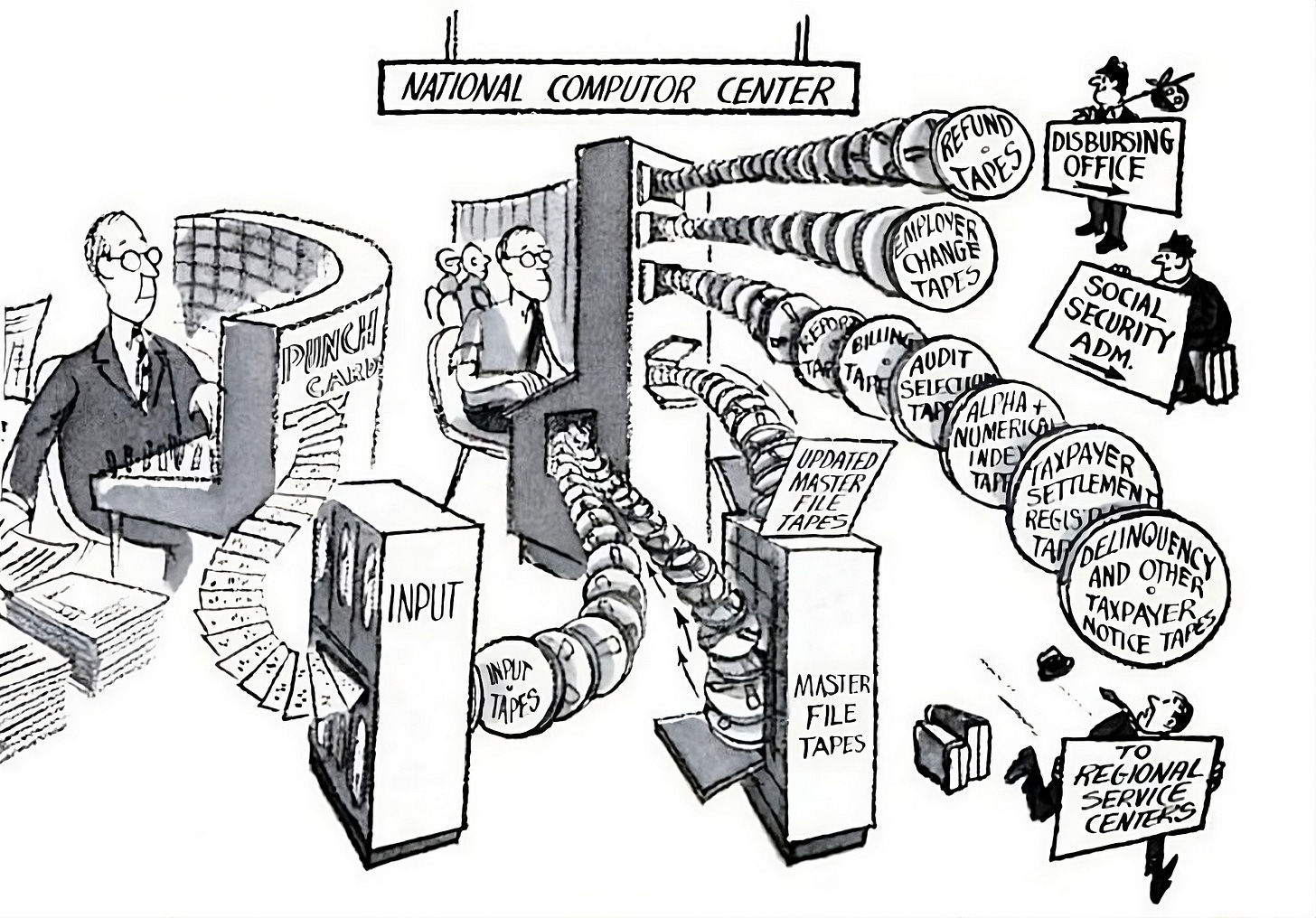
Photography was prohibited, but let me describe the scene as I remember it. It was 1988, sometime around 8 PM at the IRS Atlanta Service Center. Aside from the fact that the building was half-lit and half-empty, the first thing you'd notice would be the wires. They ran everywhere, and the building obviously hadn't been constructed with them in mind. As you walked down a corridor, passing carts full of paper returns and rows of "tingle tables," you would tread over those wires on a raised metal gangway. Each work area had an off-ramp, where both the wires and people would disembark.
I was there to see my mom, who had worked the night shift at the Atlanta Service Center for the past decade. In her section, “Correspondence Examination” (or “corr exam” in agency jargon), those wires snaked onto a series of desks. The desks were covered with dot matrix paper, cartons of files, and Sperry terminals glowing a dull monochromatic glow. These computers were linked to a mainframe in another room. Magnetic tapes from that mainframe, and from mainframes all over the country, would be airlifted to National Airport in Washington DC. From there, they'd be put on trucks to a West Virginia town of about 14,000 people called Martinsburg. There, they'd be loaded into a machine, the first version of which was known colloquially—and not entirely affectionately—as the "Martinsburg Monster." This computer amounted to something like a national nerve center for the IRS. On it programs called the Individual Master File and the Business Master File processed the country's tax records. These programs also organized much of the work. If there were a problem at Martinsburg, work across the IRS's offices spanning the continent could and frequently did shut down.

Despite decades of attempts to kill it, The IRS's Individual Master File, an almost sixty-year old accumulation of government Assembly Language, lives on. Part of this strange persistence can be pegged squarely on Congress's well-documented history of starving the IRS for funding. But another part of it is that the Individual Master File has become so completely entangled in the life of the agency that modernizing it resembles delicate surgery more than a straightforward software upgrade. Job descriptions, work processes, collective bargaining agreements, administrative law, and technical infrastructure all coalesce together and interface with it, so that a seemingly technical task requires considerable sociological, historical, legal, and political knowledge.
In 2023, as it was in the 1980s, the IRS is a cyborg bureaucracy, an entangled mass of law, hardware, software, and clerical labor. It was among the first government agencies to embrace automatic data processing and large-scale digital computing. And it used these technologies to organize work, to make decisions, and to understand itself. In important ways, the lines between the digital shadow of the agency—its artificial bureaucracy—and its physical presence became difficult if not impossible to disentangle.
This series, called Artificial Bureaucracy, is a long-term project looking at the history of government computing in the fifty-year period between 1945-1995. I think this is a timely subject. In the past several years, promoters and critics of artificial intelligence alike have talked up the possibility that decision-making and even governance itself may soon be handed over to sophisticated AI systems. What draws together both the dreams of boosters and the nightmares of critics is a deterministic orientation towards the future of technology, a conception of technology as autonomous and somehow beyond the possibility of control.
These visions mostly ignore the fact that the computerization of governance is a project at least seventy years in the making, and that project has never been determined, in the first instance or the last, primarily by "technological" factors. Like everything in government, the hardware and software systems that make up its artificial bureaucracy were and are subject to negotiation, conflict, administrative inertia, and the individual agency of its users.
Looking at government computing can also tell us something about AI. The historian of computing, Michael Mahoney has argued that studying the history of software is the process of learning how groups of people came to put their worlds in a machine. If this is right—and I think it is—our conceptions of "artificial intelligence" have an unwarranted individualistic bias; the proper way to understand machine intelligence isn't by analogy to individual human knowledge and decision-making, but to methods of bureaucratic knowledge and action. If it is about anything, the story of AI is the story of bureaucracy. And if the future of governance is AI, then it makes sense to know something about its past.
Artificial Bureaucracy will publish two issues a month, split between short articles and visual essays. My focus will be on the United States Government, but expect work on local government and other countries as well. I'll be trying to strike something of a balance between posts where I try to capture something about the phenomenology and aesthetics of government computing, and more serious writing on government software, expert systems, and data processing.




Pale King as IRS fan fiction first got me interested in this. Excited for the newsletter.
I remember the case of the IRS spending billions on a failed project to replace the master file was the intro reading for a software engineering class I had almost 20 years ago. Amazing that theyr'e still using the Individual Master File.